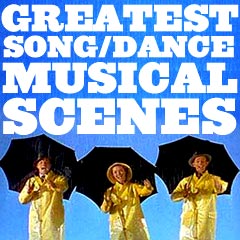
|
Musical Moments and Scenes S - 1 |
| S | ||
| Movie Title/Year and Scene Descriptions | ||
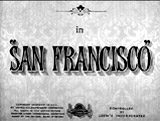
|
San Francisco (1936) Besides the earth-shattering depiction of the SF Earthquake disaster in 1906, Jeanette MacDonald (as Mary Clark) reprised the singing of the title song San Francisco (pictured) - at the annual "Chicken Ball" charity event on behalf of Barbary Coast entrepreneur Blackie Norton's (Clark Gable) Paradise gambling hall to win a $10,000 prize (rejected by Blackie). After the earthquake, she was located on a hillside in a Salvation Army camp singing Nearer My God to Thee (pictured). The Oscar-nominated film concluded with a chorus of The Battle Hymn of the Republic (pictured twice) by the throngs of survivors as they looked down on the devastated city - and imagined its reconstruction (to the reprised tune of San Francisco in the background) in the finale (pictured). |
 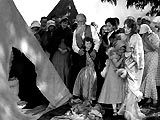   
|

|
The Sandpiper (1965)
Director Vincente Minnelli's and MGM's romantic drama of illicit love, one of the rare Hollywood films mostly made on location in the Big Sur and Monterey areas of Northern California, starred one of the most notorious real-life couples of all time (it was their third of eleven films together) - the star duo were recently-married in 1964 (after conducting adulterous affairs of their own):
During their association with each other, Laura and Dr. Hewitt began to engage in a passionate extra-marital affair. The film's poster had the tagline: "From the beginning, they knew it was wrong...but nothing could keep them apart!" The tune of the film's Oscar-winning Best Song: The Shadow of Your Smile (pictured) (aka Love Theme from The Sandpiper) (music by Johnny Mandel and lyrics by Paul Francis Webster), was heard during the opening title credits, accompanied by aerial views of the gorgeous California coastline, and performed by trumpet player Jack Sheldon. The film's title, however, referred to a wounded sandpiper bird with a broken wing (pictured) that was tended to by Laura until it was healed and able to fly.
|
 
|
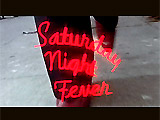
|
Saturday Night Fever (1977)
Director John Badham's Seventies' disco dance classic opened during the credits with the iconic shot of Saturday night dance king Tony Manero (Oscar-nominated John Travolta) strutting down a Brooklyn street. As the camera panned up his figure, he was revealed as a young stud dressed for the evening with a leather jacket, wide collared bright red shirt and gold chain around his neck, to the tune of the Bee Gee's Stayin' Alive (pictured thrice):
During other dance portions of the film, the main character wore a white polyester suit and strutted his stuff on a pulsating color-tiled dance floor of the 2001 Odyssey club to the songs of the Bee Gees, The Trammps and Yvonne Elliman. Other dance and musical scenes included:
|
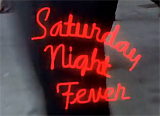 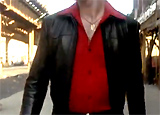 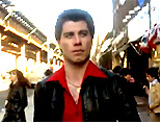 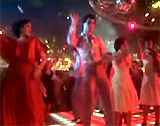 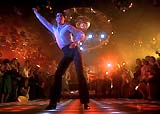 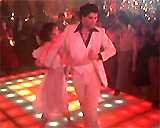
|

|
Selena (1997) In this romance-drama and musical biopic by director Gregory Nava, Jennifer Lopez starred in a breakout role as Texas-born, Mexican "Tejano" style singer. She recreated the spirit and energetic performances of future Latino superstar Selena Quintanilla-Pérez. The Warner Bros. film concluded with her assassination-shooting death in 1995 by her own crazed fan club president Yolanda Saldívar, at her Corpus Christi, Texas motel, partially seen in a montage. The final sequence was a panning shot from left to right of an empty arena's stage, unattended microphone, and band platform, with Selena's song Dreaming of You (pictured) from 1989 (written by Franne Golde and Tom Snow) playing on the soundtrack. This was followed - during a candlelight vigil - by many actual images (often in split-screen) of the popular 23 year-old singer, ending with a freeze frame of Selena (including dates of her life) (all pictured). |
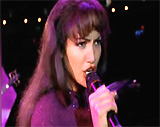 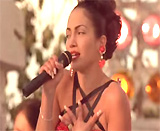  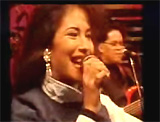 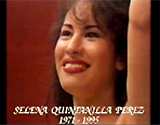
|
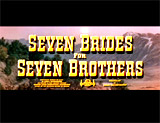
|
Seven Brides for Seven Brothers
(1954) One of the best musicals of the mid-50s was this successful Stanley Donen-directed film from MGM, in CinemaScope, with a Best Picture nomination and an Oscar-winning Musical Score (by Saul Chaplin and Adolph Deutsch). Other nominations included Best Color Cinematography, Best Film Editing, and Best Adapted Screenplay. It featured incredible dancing segments (although shot entirely on a sound stage). The musical was derived from a Stephen Vincent Benet short tale titled The Sobbin' Women. It told about the six brothers of Adam Pontipee - an Oregon farmer (Howard Keel) (the eldest of seven brothers) and his wife Milly (Jane Powell) in 1850. The unmarried brothers would eventually be married to six women in the town. The brothers (with names from A to G) were identified by different colored shirts, ultimately to be paired up with six women (they also wore different colored dresses in the 'barn-dance' sequence) - Adam and Milly were already married:
The great Gene de Paul/Johnny Mercer songs in the score included:
The lively and large-scale dance numbers - choreographed by Michael Kidd - included the 8-minute "Barn-Raising" ballet sequence (pictured) that began with a competitive challenge dance of acrobatic leaps and balletic steps (between the local guys in town and the Pontipees) - that led to a barn-raising followed by a rowdy fist-fighting brawl (pictured). |
 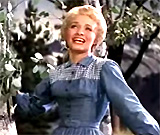 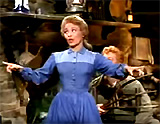 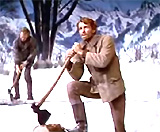 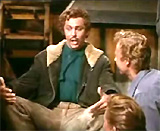   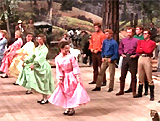 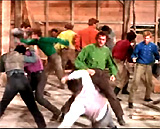
|

|
Shaft (1971)
This landmark crime/action blaxploitation film starred Richard Roundtree as the defiantly-proud, ultra-hip, leather-clad, handsome black hero: police detective John Shaft (the black version of Clint Eastwood's "Dirty Harry" Callahan in Dirty Harry (1971)) who worked in Harlem against the Mafia. It was directed by Gordon Parks and would become a major cross-over hit. Shaft had two Academy Award nominations: both for Isaac Hayes - Best Original Dramatic Score, and Best Song. Shaft won an Oscar for Hayes' memorable and stirring theme song, titled Theme From Shaft (proclaiming that Shaft was 'a private dick' who's 'a sex machine to all the chicks'). It was played as an introductory theme song during the opening credits (pictured twice) when the title character emerged from a subway onto NYC's tawdry 42nd Street (first seen in an overhead shot). |
 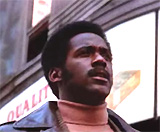
|
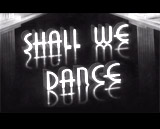
|
Shall We Dance (1937)
This classic RKO film (with an Ira and George Gershwin score), by director Mark Sandrich, marked the seventh pairing of the dancing duo of Fred Astaire and Ginger Rogers (of a total of 10 films). It has been often regarded as the last of their classic string of films together. The film's title lacked a question mark. Astaire starred as touring American ballet star Peter "Petrov" Peters (in a Paris dance troupe) and Rogers as famous musical comedy headliner and tap dancer Linda Keene. A phony romance between the two ended with their marriage and lots of misunderstanding and confusion. This film included many of their most famous numbers:
The film's happy ending was concluded with the title number Shall We Dance (pictured) featuring Fred dancing with dozens of chorus girls (with multiple Ginger Rogers masks - an idea copied from Dames (1934)) and solo dancing with Ginger herself. |
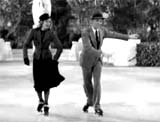 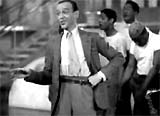  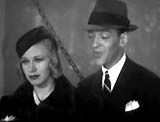 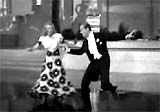  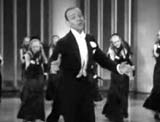
|
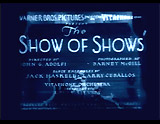
|
The Show of Shows (1929) Here was one of the first "variety" revue shows, featuring "all-talking, all singing, and all dancing" vaudeville dramatic acts and songs from dozens of Warners' stars and hosted by Master of Ceremonies emcee Frank Fay. This was originally a two-color Technicolored film, but now available as mostly black and white. The many numbers included:
In the lavish Lady Luck finale (pictured), Betty Compson and Alexander Gray starred along with 15 individual acts. The number was climaxed by each of the film's stars poking their heads through holes in a huge canvas drape (with a star design), and singing Lady Luck before the curtain closed on them. |
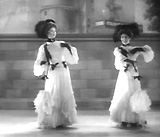 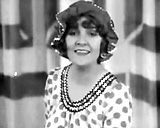 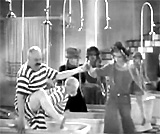 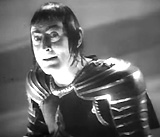  
|

|
Show Boat (1936)
This black and white 1936 film from Universal and directed by horror film master James Whale, often considered the definitive version of the material, was the best stage-to-film adaptation of the popular, long-running 1927 Broadway hit musical (by Jerome Kern and Oscar Hammerstein II) that was revived in 1932. It was derived from Edna Ferber's 1926 source novel about Cap'n Andy Hawks' showboat Cotton Blossom. There were three film versions of the musical from 1929 to 1951:
In addition to nine songs retained from the 1927/1932 stage show, three new songs were added to the 1936 film:
Three of the more notable Jerome Kern numbers were:
|
 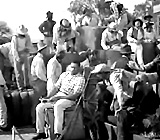 'Ol Man River' in 1936 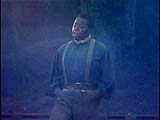 'Ol Man River' in 1951 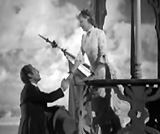 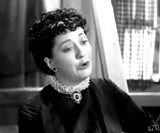 
|
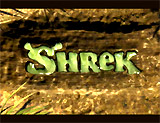
|
This computer-generated animation PDI/DreamWorks production, winner of the Best Animated Feature Film Oscar (in the first year that the new awards category was introduced). It featured parodies of well-known fairy tales, characters, and Disney and Disneyland-related items and popular films (Snow White, the Wicked Witch, Cinderella, Robin Hood - or Monsieur Hood, The Matrix, etc.), and included pop songs in its soundtrack. After the marriage of green ogre Shrek (voice of Michael Myers) and Princess Fiona (voice of Cameron Diaz) and their departure in the storybook ending, the animation ended with the celebratory song-and-dance number I'm a Believer (Neil Diamond's song, performed by Smash Mouth) sung by Donkey (voice of Eddie Murphy) (pictured) with the entire cast of fairytale creatures dancing in their own unique styles:
The DVD release included an additional three-minute segment of the film's I'm a Believer musical finale. |
 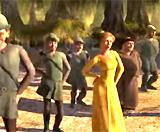 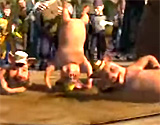
|

|
In this sequel, after green ogre Shrek (voice of Mike Myers) and Princess Fiona (voice of Cameron Diaz) had been married, they returned to Far, Far Away land, ruled by their shocked in-laws: King Harold (voice of John Cleese) and Queen Lillian (voice of Julie Andrews). The film's Oscar-nominated Best Original Song Accidentally In Love (pictured), sung by Counting Crows, played over scenes of Shrek and Fiona's honeymoon. Memorable numbers also included two show-stoppers:
Another celebratory song-and-dance ensemble number was in the closing, Ricky Martin's Livin' La Vida Loca (pictured), sung by Donkey (voice of Eddie Murphy) and ogre-killer Puss-In-Boots (voice of Antonio Banderas). [Note: The DVD release featured an American Idol spoof called "Far Far Away Idol", with Simon Cowell (as Himself) judging the film's characters.] |
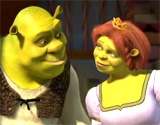 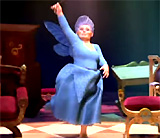 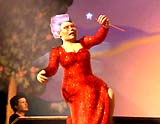 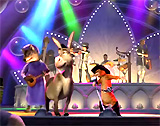
|

|
Silk Stockings (1957) Director Rouben Mamoulian's screen dance-musical (his last film) was a widescreen MGM musical remake during the Cold War era of Ernst Lubitsch's classic comedy Ninotchka (1939) with Greta Garbo, and adapted from Cole Porter's last Broadway show. It also marked 57 year-old Fred Astaire's last musical film for 10 years, and was famed Arthur Freed's first film as an independent producer at the studio. Cyd Charisse took the role of conservative Soviet spy Ninotchka Yoschenko (sent to Paris to bring back a defector) who was engaged in May-December romance with Fred Astaire (as Hollywood movie producer Steve Canfield in Paris making a film) - it was the pair's first onscreen teaming since The Band Wagon (1953). Memorable of the thirteen Cole Porter tunes were:
|
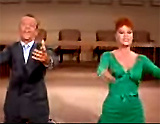 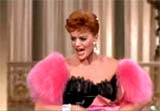 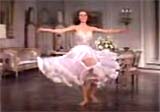 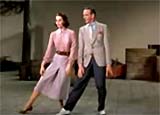  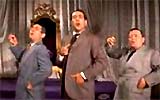
|
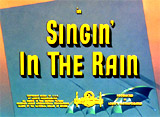
|
This MGM classic, co-directed by star Gene Kelly and Stanley Donen, featured an original story (a spoof set in the late 1920s during the age of the coming of 'talkies') by Betty Comden and Adolph Green, with a screenplay using songs from Arthur Freed and Nacio Herb Brown. It had only two unrewarded Oscar nominations: Best Score (Lennie Hayton) and Best Supporting Actress (Jean Hagen). This film's title scene (performed first in the opening title sequence) has been considered part of movie legend - as the most famous solo song-and-dance signature number in film history - it featured Gene Kelly singing the title song Singin' In the Rain (pictured) in a downpour, swinging his umbrella around, deliberately stomping in puddles, and leaping onto a lamp-post.
Also, the opening credits rendition of the title song was performed by a trio of cast members wearing yellow raincoats and sporting umbrellas (pictured):
The trio later sang the popular song Good Mornin' (pictured) in a living room. Reynolds participated in a fabulous love duet/dance You Were Meant For Me (pictured) on a deserted sound stage with Kelly, and O'Connor performed the unforgettable acrobatic, comical and slapstick song-and-dance routine Make 'Em Laugh (pictured). The film was also highlighted by the satirical song-and-dance Moses Supposes (pictured) by Kelly and O'Connor in which they rebelled against their diction coach (Bobby Watson) as well as their song-and-dance Fit As a Fiddle (pictured). Kelly and gangster's vampish moll Cyd Charisse (in her first teaming with Kelly) memorably danced in the climactic Broadway Rhythm Ballet (pictured), and the finale song was You Are My Lucky Star (pictured). |
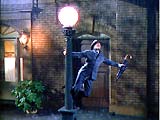 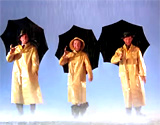  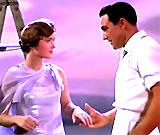 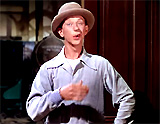 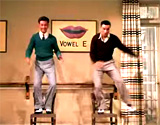 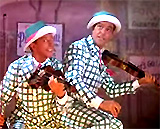 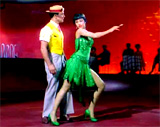 
|
(alphabetical by film title) Introduction | A-1 | A-2 | B-1 | B-2 | B-3 | C-1 | C-2 | D-1 | D-2 | E | F-1 | F-2 | G-1 | G-2 H-1 | H-2 | I-J | K | L-1 | L-2 | M-1 | M-2 | N-O | P-1 | P-2 | R-1 | R-2 | S-1 | S-2 | S-3 | T | U-V | W | X-Z |